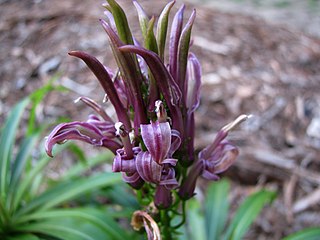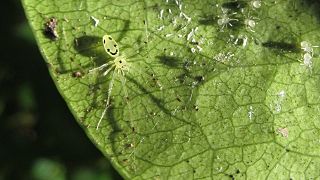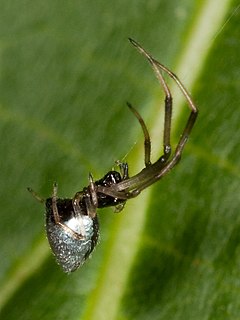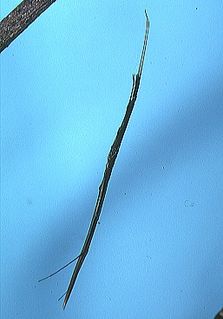
Theridiidae, also known as the tangle-web spiders, cobweb spiders and comb-footed spiders, is a large family of araneomorph spiders first described by Carl Jakob Sundevall in 1833. This diverse, globally distributed family includes over 3,000 species in 124 genera, and is the most common arthropod found in human dwellings throughout the world.

The Hawaiian lobelioids are a group of flowering plants in the bellflower family, Campanulaceae, all of which are endemic to the Hawaiian Islands. This is the largest plant radiation in the Hawaiian Islands, and indeed the largest on any island archipelago, with over 125 species. The six genera can be broadly separated based on growth habit: Clermontia are typically branched shrubs or small trees, up to 7 metres (23 ft) tall, with fleshy fruits; Cyanea and Delissea are typically unbranched or branching only at the base, with a cluster of relatively broad leaves at the apex and fleshy fruits; Lobelia and Trematolobelia have long thin leaves down a single, non-woody stem and capsular fruits with wind-dispersed seeds; and the peculiar Brighamia have a short, thick stem with a dense cluster of broad leaves, elongate white flowers, and capsular fruits.

Theridion grallator, also known as the Hawaiian happy-face spider, is a spider in the family Theridiidae that resides on the Hawaiian Islands. T. grallator obtains its vernacular name of "Hawaiian happy-face spider" from the unique patterns superimposed on its abdomen, specifically those that resemble a human smiling face. Its Hawaiian name is nananana makakiʻi. The specific epithet grallator is Latin for "stilt walker", a reference to the species' long, spindly legs. T. grallator is particularly notable because of its wide range of polymorphisms that may be studied to allow a better understanding of evolutionary mechanisms. In addition to the variety of color polymorphisms present in T. grallator, this spider also demonstrates the interesting quality of diet-induced color change, in which its appearance temporarily changes as it metabolizes various food items.

Argyrodes, also called dewdrop spiders, is a genus of comb-footed spiders that was first described by Eugène Louis Simon in 1864. They occur worldwide, and are best known for their kleptoparasitism. They can spin their own webs, but tend to invade and reside in their hosts' webs. This relationship can be commensal or even mutual if the dewdrop spider feeds on small trapped insects that are not eaten by the host. Some species can even prey upon the host.

Wirada is a genus of comb-footed spiders that was first described by Eugen von Keyserling in 1886.

Ariamnes colubrinus, known as the whip spider, is a common Australian spider belonging to the family Theridiidae. It is found in Victoria, New South Wales and Queensland.

Mongolarachne is an extinct genus of spiders placed in the monogeneric family Mongolarachnidae. The genus contains only one species, Mongolarachne jurassica, described in 2013, which is presently the largest fossilized spider on record. The type species was originally described as Nephila jurassica and placed in the living genus Nephila which contains the golden silk orb-weavers.
Ariamnes makue is a species of spider in the family Theridiidae. They are endemic to the island of Oahu in the Hawaiian Islands. Males range in size from 5.3 to 5.7 millimetres and females from 5.8 to 6.3 millimetres. The name derives from the Hawaiian word "māku'e," meaning "dark in color."
Anelosimus monskenyensis is a small species of spider in the family Theridiidae. It has only been found on Mount Kenya, the location from which its name originates. Males range in size from 1.80 to 1.90 millimetres, while females range from 1.90 to 2.55 millimetres. Specimens were shades of brown and white, although color variation is not known. They may kleptoparasitically inhabit the webs of agelenid spiders, although this behavior is not found in other Anelosimus species. Agnarsson and Zhang find it more probable that A. monskenyensis is a social or semi-social spider.
Anelosimus kohi is a species of spider in the family Theridiidae. It is found in Singapore and Malaysia. The species is named for Joseph K. H. Koh, an entomologist from Singapore who collected the holotype specimen.
Anelosimus nelsoni is a species of spider in the family Theridiidae. It is only known from iSimangaliso Wetland Park, KwaZulu-Natal, South Africa. It is named for Nelson Mandela. The male holotype specimen is 2.08 millimetres (0.082 in) in length, and the female paratype is 2.60 millimetres (0.102 in) in length. Both the holotype and paratype were found on Fanies Island, 5 km south of Cape Vidal. Both were collected from bushes or trees in an open forest patch.
Anelosimus agnar is a species of spider in the family Theridiidae. The holotype and paratype specimens were collected in Teluk Mahkota, Johor, Malaysia. Both specimens are female; this species currently lack information on males. The spider is named for Agnar Ingólfsson, the father of the discoverer, Ingi Agnarsson. Females can be identified as members of this species by unusually long and flimsy copulatory ducts. Females range in size from 2.05 to 2.40 millimetres. Both the holotype and paratype were collected from small webs at the tips of branches, from a forested area next to a beach.
Anelosimus linda is a species of spider in the family Theridiidae. The holotype and paratype specimens were collected in Cameron Highlands, Pahang, Malaysia. Both specimens are female; this species currently lack information on males. The spider is named for Linda Wendel, the mother of the discoverer, Ingi Agnarsson. Females are approximately 1.90 millimetres (0.075 in). A. linda lives in mid-elevation forest; both the holotype and paratype were collected at 1550m elevation.
Anelosimus oritoyacu is a species of tangle-web spider found in Ecuador and Mexico at altitudes from 1,800 to 2,000 metres. It is subsocial, although it has some features which distinguish it from other social or subsocial spiders in the genus. It has long-lived nest sites, unlike the social spider Anelosimus eximius which has more transitory nest sites, and its webs do not have aerial threads found in other social and sub-social species. It has a female-biased sex ratio, which is indicative of social behavior, although its sex ratio is smaller than other social species. It was first identified as distinct from Anelosimus studiosus in 2006 by Ingi Agnarsson. It is named for Oritoyacu, Ecuador, where the type specimen was collected.
Anelosimus terraincognita is a species of spider discovered in the collection of the Rijksmuseum van Natuurlijke Historie, with no associated information as to its collector or location of discovery. Males have a corkscrew-shaped embolus, which is a characteristic unique to Australasian species within the genus Anelosimus. It is known only from the holotype specimen, which has a total length of 2.2 millimetres (0.087 in). It is named for the cartographic Latin phrase terra incognita, meaning unknown land.
Anelosimus bali is a species of spider found in Bali, Indonesia, after which the species is named. It is a coastal species, found in small-leaved mangrove trees along the beach. The holotype is female and 2.9 millimetres (0.11 in) long. No male specimens have been identified, and the social structure of the species is not known. It was first identified in 2012 by Ingi Agnarsson.
Anelosimus pratchetti is a species of tangle-web spider found in New South Wales, Australia. Initial field observations indicate it is a subsocial spider. It lives in low elevation environments, including beachfront mangrove forests. It was identified by Ingi Agnarsson in 2012, who named the species after Terry Pratchett, whom Agnarsson described as "a comic genius."

Orsonwelles is a genus of American dwarf spiders that was first described by G. Hormiga in 2002. They are all native to the Hawaiian Islands, each species occurring on a single island, often at high elevations. One species has not been collected since the 1890s, and is believed to be extinct. The name honors the actor and film-maker Orson Welles. Many of the species names commemorate elements from Welles' films, radio productions, or roles.
Ariamnes waikula is a species of spider from the family Theridiidae. The species is known only from the island of Hawaii, in the state of Hawaii. The type specimen was collected from wet forest habitat at 1,067 meters (3,501 ft) elevation. The species is named for its gold-colored abdomen using the Hawaiian word for gold-colored, "waikula." A scientific description of this species was first published in 2007 by Gillespie & Rivera.

Ariamnes cylindrogaster is a spider belonging to the family Theridiidae. It is found from Laos to Taiwan.








